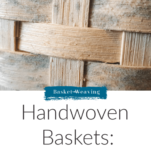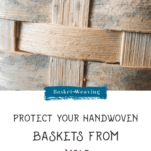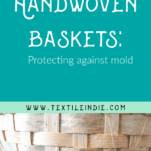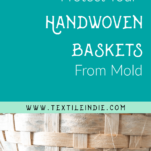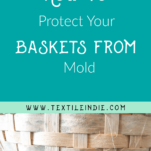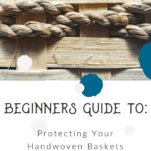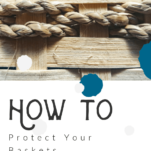For a complete guide to all Textile Indie’s basket weaving posts and videos, visit the main Basket Weaving Page.
Why protect your baskets?
Mold, light, water, dirt, and staining…..all potential problems that can attack your beautifully woven baskets.
I was digging through a basket of yarn the other day when I realized that the basket was growing an unnatural color of green fuzz – and it wasn’t the yarn!
When I inspected it closer, I found a thin layer of mold growing on my yarn basket’s reed and seagrass. My chin hit the floor. A basket that I had worked to create, one that belonged to a set of six matching baskets, was ruined. What a disappointment!
I ran around the house checking all the other baskets in my set. Sure enough, all the others in were showing signs of mold. The baskets had retained or absorbed enough moisture in our Pacific Northwest climate to create a healthy breeding ground for this science experiment.
YouTube video about a basket I rescued
How to remove mold from a basket
I made these baskets years ago and didn’t realize the importance of protecting the reed from moisture.
Happily, I figured out a way to rescue my hard work.
Here’s how I brought them back to life:
Soaking and scrubbing
I soaked and scrubbed the baskets with Method antibacterial cleaner. I like spearmint, but it comes in a variety of natural scents.
When all signs of mold had been washed away, I set them in front of a fan to speed the drying process and ensure that everything dried thoroughly.
I usually recommend allowing baskets to dry naturally so they don’t crack, but in this case, I wanted to get all the moisture out as fast as possible so the mold didn’t have a chance to repopulate.
How to protect your baskets from mold
After the baskets dried, I took a spray can of Danish Oil Wood sealer (clear natural) and sprayed each basket inside and out. I put two coats on each basket, allowing them to dry for 20 minutes between each coat (the can says 10 minutes between each coat, but I ended up waiting 20 minutes to be sure).

This oil stain smells, so I suggest keeping the baskets outdoors while they dry and letting them de-stink before bringing them into the house. The smell goes away after about two days.
Also, don’t spray this stuff in the house, do it outside! It comes out in a mist that fills the air with little droplets – not good to breathe.
The Danish Oil I used darkened the reed slightly. I prefer the lighter natural reed color, so this is what I was going for. I am happy with the outcome and will be using this on future baskets.
In the past, I have used a canned oil or water-based wood sealer and applied it with a brush. This is another option (potentially cheaper, though I haven’t done the math).
I have used this sealer with a good outcome: Watco Danish Oil Finish.
I discovered that the spray can is a lot more convenient, easy to use, and super easy to clean up. I found the spray sealer at basketweaving.com here.
We put a lot of time and money into our handwoven baskets; it’s important to take good care of them. Though sealing them may not be the most natural thing to do, I do like that my baskets don’t mold when sealed.
Do you want the best resources, tools, and products for fiber artists?
Every other Friday, I send an email chock full of fiber craft inspiration for you to explore.
Each issue focuses on one fiber art skill – spinning, dyeing, basket weaving…
My complete YouTube video on staining and sealing baskets
I hope you can save any of your baskets that have seen better days.
For a complete list of basket terminology:
For a complete guide to all Textile Indie’s basket weaving posts and videos, visit the main Basket Weaving Page.
More basket weaving techniques:
How to Cut Reed for Basket Stakes
How to Weave an Open Basket Base
How to Weave a Closed Basket Base
Twining a Basket Base: Creating a Stable Basket
Weaving Techniques for Basket Making
How to Set Up the Rim of a Basket
How to do Basic Lashing on a Basket Rim
How to do Cross-Stitch or X-Lashing on a Basket Rim
Signing Your Handwoven Baskets: Leaving a Legacy
Basket Stains and Sealers: Finishing Your Basket
Basketry Immersion: A Year-Long Journey
Check out Textile Indie’s self-paced basket program if you want to learn to weave beautiful baskets.
Twelve different basket designs with video and written instructional support to learn foundational basketry techniques.
Over the course of twelve months, you will receive one basket pattern and a video with supporting instructional material each month. Start at basket one and weave all twelve.




